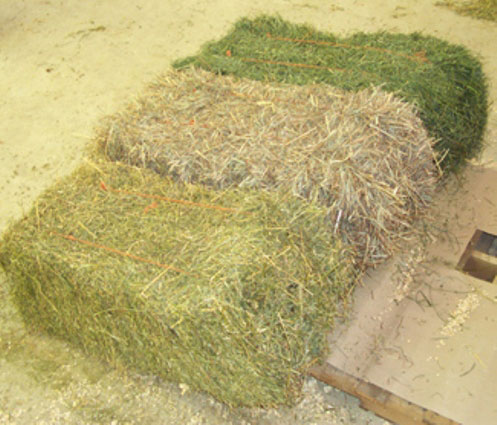Feeding different cuttings or species of hay to horses during drought
Michigan horse owners may need to consider feeding different types of hay this winter and early spring.

Photo: The nutritional value of hay is determined by the forage species and maturity at harvest.
If you have always fed second cutting grass hay, this may be the year you need to try something new. Hay, whether cut earlier or later in the season, is dependent on maturity at harvest and species to determine its overall nutritional value. As hay matures in the field, it will decrease in both energy and protein, regardless if it is first, second or third cutting. Birdsfoot trefoil, a legume primarily harvested in the Upper Peninsula, is the exception to this and keeps its quality for a longer period compared to grass or alfalfa when mature. Legumes in general will be higher in energy and protein that grasses.
Legume plants are more drought resistant than cool season grasses, and it may be that you will get more quality nutrition with a mixed hay (grass and alfalfa) or even alfalfa hay this year. You should always feed grain based on the type of hay you are feeding. So if you are feeding hay with more energy and protein than you usually feed, you will probably need to decrease the amount of grain you are feeding – otherwise you may end up with an overweight horse. By the same token, if you are feeding more mature hay than you have in the past, you may need to increase your horse’s grain ration to ensure your horse gets adequate energy in its diet.
You can also feed hay that is over a year old as long as it is clean and dry. All hay loses vitamin stores relatively quickly (in about three to six months of storage). We always assume that we need to supplement essential vitamins and some minerals based on where hay is grown and the species type. Supplementing hay with a hay balancer or formulated grain that is specific for your horse’s dietary requirements can ensure your horse is getting a balanced diet. Remember to body condition score your horse often to ensure they are neither to fat nor thin.
To learn more about body condition scoring in horses, visit Michigan State University (MSU) Extension’s website.
Finally, avoid feeding moldy or dusty hay. Moldy hay can cause colic in horses while dusty hay can lead to respiratory problems. Older horses are particularly susceptible to heaves, a respiratory condition that can be aggravated by dusty, moldy hay.
Visit My Horse University to learn more about optimizing hay and feeding storage.
Related MSU Extension News articles:
- Purchasing forage for horses in a drought year
- Feeding round bales to horses during drought
- Stretching hay supplies for horses in a drought year
Additional information:
- MSU Extension’s Drought Resources



 Print
Print Email
Email

